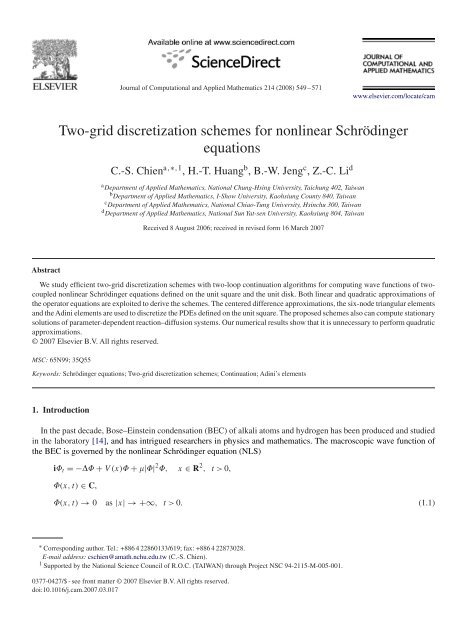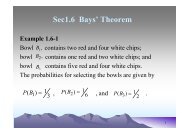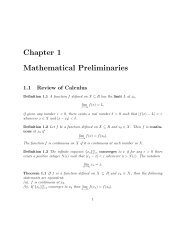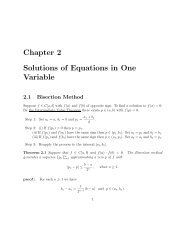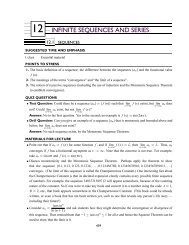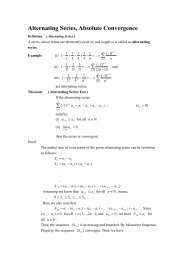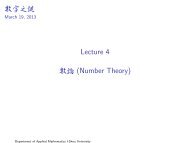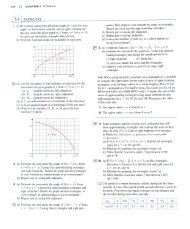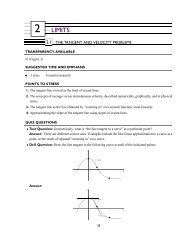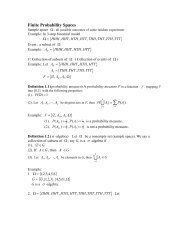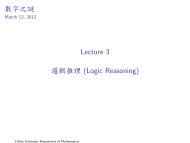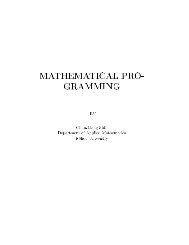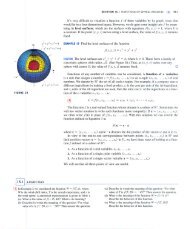Two-grid discretization schemes for nonlinear Schrödinger equations
Two-grid discretization schemes for nonlinear Schrödinger equations
Two-grid discretization schemes for nonlinear Schrödinger equations
You also want an ePaper? Increase the reach of your titles
YUMPU automatically turns print PDFs into web optimized ePapers that Google loves.
Journal of Computational and Applied Mathematics 214 (2008) 549 – 571<br />
www.elsevier.com/locate/cam<br />
<strong>Two</strong>-<strong>grid</strong> <strong>discretization</strong> <strong>schemes</strong> <strong>for</strong> <strong>nonlinear</strong> Schrödinger<br />
<strong>equations</strong><br />
C.-S. Chien a,∗,1 , H.-T. Huang b , B.-W. Jeng c , Z.-C. Li d<br />
a Department of Applied Mathematics, National Chung-Hsing University, Taichung 402, Taiwan<br />
b Department of Applied Mathematics, I-Show University, Kaohsiung County 840, Taiwan<br />
c Department of Applied Mathematics, National Chiao-Tung University, Hsinchu 300, Taiwan<br />
d Department of Applied Mathematics, National Sun Yat-sen University, Kaohsiung 804, Taiwan<br />
Received 8 August 2006; received in revised <strong>for</strong>m 16 March 2007<br />
Abstract<br />
We study efficient two-<strong>grid</strong> <strong>discretization</strong> <strong>schemes</strong> with two-loop continuation algorithms <strong>for</strong> computing wave functions of twocoupled<br />
<strong>nonlinear</strong> Schrödinger <strong>equations</strong> defined on the unit square and the unit disk. Both linear and quadratic approximations of<br />
the operator <strong>equations</strong> are exploited to derive the <strong>schemes</strong>. The centered difference approximations, the six-node triangular elements<br />
and the Adini elements are used to discretize the PDEs defined on the unit square. The proposed <strong>schemes</strong> also can compute stationary<br />
solutions of parameter-dependent reaction–diffusion systems. Our numerical results show that it is unnecessary to per<strong>for</strong>m quadratic<br />
approximations.<br />
© 2007 Elsevier B.V. All rights reserved.<br />
MSC: 65N99; 35Q55<br />
Keywords: Schrödinger <strong>equations</strong>; <strong>Two</strong>-<strong>grid</strong> <strong>discretization</strong> <strong>schemes</strong>; Continuation; Adini’s elements<br />
1. Introduction<br />
In the past decade, Bose–Einstein condensation (BEC) of alkali atoms and hydrogen has been produced and studied<br />
in the laboratory [14], and has intrigued researchers in physics and mathematics. The macroscopic wave function of<br />
the BEC is governed by the <strong>nonlinear</strong> Schrödinger equation (NLS)<br />
iΦ t =−ΔΦ + V(x)Φ + μ|Φ| 2 Φ, x ∈ R 2 , t >0,<br />
Φ(x, t) ∈ C,<br />
Φ(x, t) → 0 as |x| →+∞, t >0. (1.1)<br />
∗ Corresponding author. Tel.: +886 4 22860133/619; fax: +886 4 22873028.<br />
E-mail address: cschien@amath.nchu.edu.tw (C.-S. Chien).<br />
1 Supported by the National Science Council of R.O.C. (TAIWAN) through Project NSC 94-2115-M-005-001.<br />
0377-0427/$ - see front matter © 2007 Elsevier B.V. All rights reserved.<br />
doi:10.1016/j.cam.2007.03.017
550 C.-S. Chien et al. / Journal of Computational and Applied Mathematics 214 (2008) 549 – 571<br />
Here Φ = Φ(x, t) is the wave function of the BEC, V(x)= 1 2 (γ2 1 x2 1 + γ2 2 x2 2 ) the trapping potential with γ 1 and γ 2 as<br />
the trap frequencies in x 1 - and x 2 -axis, respectively. The trapping potential is isotropic if γ 1 = γ 2 , otherwise it is called<br />
nonisotropic. The coefficient μ can be positive or negative depending on the interaction is repulsive or attractive. Eq.<br />
(1.1) has been studied extensively <strong>for</strong> many years because of their importance in physical and mathematical problems.<br />
Experimental reports concerning the BEC can be found, e.g., in [1,14]. Mathematical and numerical study of (1.1)<br />
can be found in [3–5,18]. To compute wave functions of (1.1), in general one has to discretize or integrate the partial<br />
derivative of Φ with respect to t. For instance, Bao et al. [5] used time-splitting spectral <strong>discretization</strong>s to compute<br />
wave functions of (1.1).<br />
In this paper, we will study two-<strong>grid</strong> <strong>discretization</strong> <strong>schemes</strong> <strong>for</strong> computing stationary state solutions of the twocoupled<br />
<strong>nonlinear</strong> Schrödinger <strong>equations</strong> (TCNLS)<br />
i t Φ j =−ΔΦ j + V j (x)Φ j + μ j |Φ j | 2 Φ j + ∑ β ij |Φ i | 2 Φ j <strong>for</strong> x ∈ R 2 , t >0,<br />
i̸=j<br />
Φ j = Φ j (x, t) ∈ C, j = 1, 2,<br />
Φ j (x, t) → 0 as |x| →+∞, t >0, (1.2)<br />
where Φ j and V j (x) have the same meaning as those of Φ and V(x)in (1.1). The coefficients μ j can be positive or<br />
negative. The coupling constant β ij is the interaction between Φ 1 and Φ 2 . We say the interaction is repulsive if β ij > 0,<br />
and attractive if β ij < 0. For simplicity we let β 12 = β 21 = β. Eq. (1.2) describes uniting two grown condensates to<br />
<strong>for</strong>m one large single condensate. The first experiment involving the uniting of multicomponent BEC was reported in<br />
[20]. Bao [2] studied ground states and dynamics of multicomponent BEC using a continuous normalized gradient flow<br />
(CNGF), the backward Euler finite difference (BEFD), and a time-splitting sine-spectral method. Ghosh [12] studied<br />
the dynamics of the TCNLS. Recently, Chang et al. [7] proposed a time-independent approach <strong>for</strong> computing wave<br />
functions of (1.2). To be precise, let<br />
Φ j (x, t) = e −iλ j t u j (x), (1.3)<br />
where λ j are the chemical potentials of the system. Then (1.2) can be trans<strong>for</strong>med into<br />
−Δu 1 − λ 1 u 1 + V 1 (x)u 1 + μ 1 u 3 1 + βu 1u 2 2 = 0 in Ω,<br />
−Δu 2 − λ 2 u 2 + V 2 (x)u 2 + μ 2 u 3 2 + βu 2u 2 1 = 0 in Ω,<br />
u 1 = u 2 = 0 on Ω, (1.4)<br />
where Ω ⊂ R 2 is a smooth domain with piecewise smooth boundary Ω. Note that in (1.1) and (1.2) the solutions<br />
decay to zero in the far-field. Thus, in practical computation, the domain Ω should be chosen as large as possible if we<br />
impose Dirichlet boundary conditions on it. The solutions Φ j also represent the jth component of the beam in Kerr-like<br />
photorefractive media.<br />
Eq. (1.4) is a <strong>nonlinear</strong> system of <strong>equations</strong> involving multiparameters. The solution manifolds of (1.4) can be traced<br />
numerically using continuation methods, where one of the chemical potentials, say λ 1 , is used as the continuation<br />
parameter; see e.g., [6] and the further references cited therein. If the solution manifolds of (1.4) is numerically<br />
traced, then the wave functions of (1.2) can be easily obtained using (1.3). In [10] Chien and Jeng proposed two-<strong>grid</strong><br />
<strong>discretization</strong> <strong>schemes</strong> <strong>for</strong> tracing solution manifolds of semilinear elliptic eigenvalue problems, where both centered<br />
difference approximations and the six-node triangular elements were used to discretize the PDEs. In this paper, we will<br />
derive a two-<strong>grid</strong> <strong>discretization</strong> scheme so that the wave functions of (1.2) can be computed efficiently. To derive two<strong>grid</strong><br />
<strong>discretization</strong> <strong>schemes</strong> <strong>for</strong> <strong>nonlinear</strong> eigenvalue problems, one of the main concerns is that which <strong>discretization</strong><br />
method should be used so that singular points of the PDEs such as folds and bifurcation points can be accurately<br />
approximated. Besides the <strong>discretization</strong> <strong>schemes</strong> exploited in [10], the high order Adini elements will also be used<br />
to discretize the PDEs. Recently, Huang et al. [15,16] studied global superconvergence and error estimates of Adini’s<br />
elements <strong>for</strong> the Poisson type <strong>equations</strong>. The advantage of implementing Adini’s elements is that less elements are<br />
required to obtain approximate solutions with high accuracy especially when the domain is rectangular.
C.-S. Chien et al. / Journal of Computational and Applied Mathematics 214 (2008) 549 – 571 551<br />
The two-<strong>grid</strong> <strong>discretization</strong> <strong>schemes</strong> we propose here also can be used to compute stationary solutions of parameterdependent<br />
reaction–diffusion systems of the following <strong>for</strong>m [21]:<br />
u<br />
t = d 1Δu + f (u, v, λ) in Ω,<br />
v<br />
t = d 2Δv + g(u, v, λ) in Ω (1.5)<br />
<strong>for</strong> all t 0, subject to suitable boundary conditions. Here u and v represent the state variables, λ ∈ R k is the parameter<br />
vector, and the domain Ω is defined as in (1.4). Eq. (1.5) is used as a mathematical model <strong>for</strong> various types of problems in<br />
sciences and engineering, e.g., the Brusselator [22] in chemistry, the Gierer–Meinhardt system [13], the Lotka–Volterra<br />
system [19] in mathematical biology, and so on. We wish to mention here that during the past years some two-<strong>grid</strong><br />
mixed finite element <strong>discretization</strong> <strong>schemes</strong> have been developed <strong>for</strong> reaction–diffusion <strong>equations</strong> [8,24,25].<br />
This paper is organized as follows. In Section 2 we derive linear and quadratic approximations <strong>for</strong> (1.5) in the<br />
rectangular coordinates. The two-<strong>grid</strong> centered difference <strong>discretization</strong> algorithms are described in Section 3. The<br />
two-<strong>grid</strong> finite element counterparts can be described in a similar way and is omitted here. We show in Section 4 how<br />
the two-<strong>grid</strong> centered difference <strong>discretization</strong> <strong>schemes</strong> can be adapted to the polar coordinates. In Section 5 we give<br />
centered difference approximations <strong>for</strong> (1.4) and the Brusselator. We also briefly discuss the Adini’s elements therein.<br />
Sample numerical results are reported in Section 6. Finally, some concluding remarks are given in Section 7.<br />
2. Linear and quadratic approximations<br />
For convenience we consider (1.5) <strong>for</strong> all t 0, subject to the homogenous Dirichlet boundary conditions<br />
u(x,y,t)= u 0 , v(x,y,t)= v 0 , (x,y) ∈ Ω. (2.1)<br />
Here the unknowns u, v are state variables which represent concentrations of some intermediate chemicals in the<br />
reaction, d 1 and d 2 are diffusion rates, while λ ∈ R is one of the control parameters in the system, e.g., initial or final<br />
products, catalysts, temperature, etc., and (u 0 ,v 0 ) is a uni<strong>for</strong>m steady state solution, i.e., u 0 , v 0 are independent of the<br />
variables t, x, y which satisfy<br />
f(u 0 ,v 0 , λ) = g(u 0 ,v 0 , λ) = 0.<br />
We assume that the functions f and g are at least twice continuously differentiable.<br />
We rewrite the stationary state of (1.5) as<br />
[ ] [ ]<br />
1 (u, v, λ) d1 Δu + f (u, v, λ)<br />
Φ(u, v, λ) =<br />
=<br />
= 0 in Ω, (2.2)<br />
2 (u, v, λ) d 2 Δv + g(u, v, λ)<br />
where Φ : B 1 × B 1 × R k → B 2 is a smooth mapping with u 1 ,u 2 ∈ B 1 , λ ∈ R k with B 1 and B 2 two Banach spaces. Let<br />
˜h, h ∈ (0, 1) be any two fixed positive numbers. Since we will use the solution manifolds of (1.4) together with (1.3)<br />
to compute wave functions of (1.2), we discretize (2.2) by using centered differences or finite elements on the coarse<br />
<strong>grid</strong> with uni<strong>for</strong>m meshsize ˜h. Let (u ˜h ,v˜h , λ ˜h<br />
) be an approximate stationary state solution of (1.5) on the coarse <strong>grid</strong>,<br />
and (u, v, λ ˜h<br />
) the counterpart on the fine <strong>grid</strong> with uni<strong>for</strong>m meshsize h. The linear approximations of the mappings<br />
1 (u, v, λ ˜h ) and 2(u, v, λ ˜h ) at (u ˜h<br />
,v˜h<br />
)are given by<br />
1 (u, v, λ ˜h ) ≈ 1(u ˜h ,v˜h , λ ˜h ) + D u 1 (u ˜h ,v˜h , λ ˜h )(u − u ˜h ) + D v 1 (u ˜h ,v˜h , λ ˜h )(v − v ˜h ),<br />
2 (u, v, λ ˜h ) ≈ 2(u ˜h ,v˜h , λ ˜h ) + D u 2 (u ˜h ,v˜h , λ ˜h )(u − u ˜h ) + D v 2 (u ˜h ,v˜h , λ ˜h )(v − v ˜h<br />
). (2.3)<br />
Setting e 1 = u − u ˜h and e 2 = v − v ˜h<br />
. Eq. (2.3) becomes<br />
D u 1 (u ˜h ,v˜h , λ ˜h )e 1 + D v 1 (u ˜h ,v˜h , λ ˜h )e 2 ≈− 1 (u ˜h ,v˜h , λ ˜h ),<br />
D u 2 (u ˜h ,v˜h , λ ˜h )e 1 + D v 2 (u ˜h ,v˜h , λ ˜h )e 2 ≈− 2 (u ˜h ,v˜h , λ ˜h<br />
). (2.4)
552 C.-S. Chien et al. / Journal of Computational and Applied Mathematics 214 (2008) 549 – 571<br />
Note that<br />
D u 1 (u ˜h ,v˜h , λ ˜h )e 1 = d 1 Δe 1 + f<br />
u (u ˜h ,v˜h , λ ˜h )e 1,<br />
D v 1 (u ˜h ,v˜h , λ ˜h )e 2 = f<br />
v (u ˜h ,v˜h , λ ˜h )e 2,<br />
D u 2 (u ˜h ,v˜h , λ ˜h )e 1 = g<br />
u (u ˜h ,v˜h , λ ˜h )e 1,<br />
D v 2 (u ˜h ,v˜h , λ ˜h )e 2 = d 2 Δe 2 + g<br />
v (u ˜h ,v˜h , λ ˜h )e 2.<br />
Thus (2.4) can be expressed as<br />
d 1 Δe 1 + f<br />
u (u ˜h ,v˜h , λ ˜h )e 1 + f<br />
v (u ˜h ,v˜h , λ ˜h )e 2 ≈−d 1 Δu ˜h − f(u˜h ,v˜h , λ ˜h ),<br />
d 2 Δe 2 + g<br />
u (u ˜h ,v˜h , λ ˜h )e 1 + g<br />
v (u ˜h ,v˜h , λ ˜h )e 2 ≈−d 2 Δv ˜h − g(u˜h ,v˜h , λ ˜h ).<br />
The state variables of the approximate solution (u ˜h ,v˜h , λ ˜h<br />
) can be corrected on the fine <strong>grid</strong> by solving the following<br />
<strong>equations</strong>:<br />
d 1 Δe 1 + f<br />
u (u ˜h ,v˜h , λ ˜h )e 1 + f<br />
v (u ˜h ,v˜h , λ ˜h )e 2 =−d 1 Δu ˜h − f(u˜h ,v˜h , λ ˜h<br />
) in Ω =[0,l]×[0, 1]<br />
d 2 Δe 2 + g<br />
u (u ˜h ,v˜h , λ ˜h )e 1 + g<br />
v (u ˜h ,v˜h , λ ˜h )e 2 =−d 2 Δv ˜h − g(u˜h ,v˜h , λ ˜h<br />
) in Ω =[0,l]×[0, 1] (2.5)<br />
with Dirichlet boundary conditions<br />
e 1 (x, y) = 0,<br />
e 2 (x, y) = 0, (x,y) ∈ Ω.<br />
In other words, the correction (e 1 ,e 2 ) on the fine <strong>grid</strong> is obtained by solving the following system of PDEs with<br />
Dirichlet boundary conditions:<br />
⎡<br />
d 1 Δ + f<br />
⎢ u (u ˜h ,v˜h , λ ˜h ) f<br />
⎤<br />
v (u ˜h ,v˜h , λ ˜h ) [ ] [<br />
⎥ e1 −d1 Δu<br />
⎣ g<br />
u (u ˜h ,v˜h , λ ˜h ) d 2Δ + g ⎦ =<br />
˜h − f(u˜h ,v˜h , λ ˜h )<br />
]<br />
v (u ˜h ,v˜h , λ ˜h ) e 2 −d 2 Δv ˜h − g(u˜h ,v˜h , λ ˜h ) . (2.6)<br />
Since the functions f and g are twice continuously differentiable, the quadratic approximations of 1 (u, v, λ ˜h ) and<br />
2 (u, v, λ ˜h ) at (u ˜h<br />
,v˜h<br />
) <strong>for</strong> the further corrections on the coarse <strong>grid</strong> are<br />
1 (u, v, λ ˜h ) ≈ 1(u ˜h ,v˜h , λ ˜h ) + D u 1 (u ˜h ,v˜h , λ ˜h )(u − u ˜h ) + D v 1 (u ˜h ,v˜h , λ ˜h )(v − v ˜h )<br />
+ 1 2 [D uu 1 (u ˜h ,v˜h , λ ˜h )(u − u ˜h )2 + 2D uv 1 (u ˜h ,v˜h , λ ˜h )(u − u ˜h )(v − v ˜h )<br />
+ D vv 1 (u ˜h ,v˜h , λ ˜h )(v − v ˜h )2 ],<br />
2 (u, v, λ ˜h ) ≈ 2(u ˜h ,v˜h , λ ˜h ) + D u 2 (u ˜h ,v˜h , λ ˜h )(u − u ˜h ) + D v 2 (u ˜h ,v˜h , λ ˜h )(v − v ˜h )<br />
+ 1 2 [D uu 2 (u ˜h ,v˜h , λ ˜h )(u − u ˜h )2 + 2D uv 2 (u ˜h ,v˜h , λ ˜h )(u − u ˜h )(v − v ˜h )<br />
+ D vv 2 (u ˜h ,v˜h , λ ˜h )(v − v ˜h )2 ]. (2.7)
C.-S. Chien et al. / Journal of Computational and Applied Mathematics 214 (2008) 549 – 571 553<br />
Then<br />
D u 1 (u ˜h ,v˜h , λ ˜h )(ẽ 1 + e 1 ) + D v 1 (u ˜h ,v˜h , λ ˜h )(ẽ 2 + e 2 )<br />
≈− 1 (u ˜h ,v˜h , λ ˜h ) − 1 2 [D uu 1 (u ˜h ,v˜h , λ ˜h )(ẽ 1 + e 1 ) 2 + 2D uv 1 (u ˜h ,v˜h , λ ˜h )(ẽ 1 + e 1 )(ẽ 2 + e 2 )<br />
+ D vv 1 (u ˜h ,v˜h , λ ˜h )(ẽ 2 + e 2 ) 2 ],<br />
D u 2 (u ˜h ,v˜h , λ ˜h )(ẽ 1 + e 1 ) + D v 2 (u ˜h ,v˜h , λ ˜h )(ẽ 2 + e 2 )<br />
≈− 2 (u ˜h ,v˜h , λ ˜h ) − 1 2 [D uu 2 (u ˜h ,v˜h , λ ˜h )(ẽ 1 + e 1 ) 2 + 2D uv 2 (u ˜h ,v˜h , λ ˜h )(ẽ 1 + e 1 )(ẽ 2 + e 2 )<br />
+ D vv 2 (u ˜h ,v˜h , λ ˜h )(ẽ 2 + e 2 ) 2 ], (2.8)<br />
where ẽ 1 = u − u ˜h − e 1 and ẽ 2 = v − v ˜h − e 2. Note that<br />
D uu 1 (u ˜h ,v˜h , λ ˜h )(ẽ 1 + e 1 ) 2 = 2 f<br />
u 2 (u ˜h ,v˜h , λ ˜h )(ẽ 1 + e 1 ) 2 ,<br />
D uv 1 (u ˜h ,v˜h , λ ˜h )(ẽ 1 + e 1 )(ẽ 2 + e 2 ) = 2 f<br />
vu (u ˜h ,v˜h , λ ˜h )(ẽ 1 + e 1 )(ẽ 2 + e 2 ),<br />
D vv 1 (u ˜h ,v˜h , λ ˜h )(ẽ 2 + e 2 ) 2 = 2 f<br />
v 2 (u ˜h ,v˜h , λ ˜h )(ẽ 2 + e 2 ) 2 ,<br />
D uu 2 (u ˜h ,v˜h , λ ˜h )(ẽ 1 + e 1 ) 2 = 2 g<br />
u 2 (u ˜h ,v˜h , λ ˜h )(ẽ 1 + e 1 ) 2 ,<br />
D uv 2 (u ˜h ,v˜h , λ ˜h )(ẽ 1 + e 1 )(ẽ 2 + e 2 ) = 2 g<br />
vu (u ˜h ,v˜h , λ ˜h )(ẽ 1 + e 1 )(ẽ 2 + e 2 ),<br />
D vv 2 (u ˜h ,v˜h , λ ˜h )(ẽ 2 + e 2 ) 2 = 2 g<br />
v 2 (u ˜h ,v˜h , λ ˜h )(ẽ 2 + e 2 ) 2 .<br />
Thus (2.8) can be expressed as<br />
d 1 Δ(ẽ 1 + e 1 ) + f<br />
u (u ˜h ,v˜h , λ ˜h )(ẽ 1 + e 1 ) + f<br />
v (u ˜h ,v˜h , λ ˜h )(ẽ 2 + e 2 )<br />
≈−d 1 Δu ˜h − f(u˜h ,v˜h , λ ˜h ) − 1 [ 2 f<br />
2 u 2 (u ˜h ,v˜h , λ ˜h )(ẽ 1 + e 1 ) 2 + 2 2 f<br />
vu (u ˜h ,v˜h , λ ˜h )(ẽ 1 + e 1 )(ẽ 2 + e 2 )<br />
]<br />
+ 2 f<br />
v 2 (u ˜h ,v˜h , λ ˜h )(ẽ 2 + e 2 ) 2 ,<br />
d 2 Δ(ẽ 2 + e 2 ) + g<br />
u (u ˜h ,v˜h , λ ˜h )(ẽ 1 + e 1 ) + g<br />
v (u ˜h ,v˜h , λ ˜h )(ẽ 2 + e 2 )<br />
≈−d 2 Δv ˜h − g(u˜h ,v˜h , λ ˜h ) − 1 2<br />
[ 2 g<br />
u 2 (u ˜h ,v˜h , λ ˜h )(ẽ 1 + e 1 ) 2 + 2 2 g<br />
vu (u ˜h ,v˜h , λ ˜h )(ẽ 1 + e 1 )(ẽ 2 + e 2 )<br />
+ 2 g<br />
v 2 (u ˜h ,v˜h , λ ˜h )(ẽ 2 + e 2 ) 2 ]<br />
. (2.9)
554 C.-S. Chien et al. / Journal of Computational and Applied Mathematics 214 (2008) 549 – 571<br />
Since (e 1 ,e 2 ) is the solution of (2.5), the system (2.9) becomes<br />
d 1 Δẽ 1 + f<br />
u (u ˜h ,v˜h , λ ˜h )ẽ 1 + f<br />
v (u ˜h ,v˜h , λ ˜h )ẽ 2<br />
≈− 1 [ 2 f<br />
2 u 2 (u ˜h ,v˜h , λ ˜h )(ẽ 1 + e 1 ) 2 + 2 f<br />
vu (u ˜h ,v˜h , λ ˜h )(ẽ 1 + e 1 )(ẽ 2 + e 2 )<br />
]<br />
+ 2 f<br />
uv (u ˜h ,v˜h , λ ˜h )(ẽ 2 + e 2 )(ẽ 1 + e 1 ) + 2 f<br />
v 2 (u ˜h ,v˜h , λ ˜h )(ẽ 2 + e 2 ) 2<br />
≈− 1 2<br />
[ 2 ]<br />
f<br />
u 2 (u ˜h ,v˜h , λ ˜h )e2 1 + 2 2 f<br />
vu (u ˜h ,v˜h , λ ˜h )e 1e 2 + 2 f<br />
v 2 (u ˜h ,v˜h , λ ˜h )e2 2 ,<br />
d 2 Δẽ 2 + g<br />
u (u ˜h ,v˜h , λ ˜h )ẽ 1 + g<br />
v (u ˜h ,v˜h , λ ˜h )ẽ 2<br />
≈− 1 [ 2 g<br />
2 u 2 (u ˜h ,v˜h , λ ˜h )(ẽ 1 + e 1 ) 2 + 2 g<br />
vu (u ˜h ,v˜h , λ ˜h )(ẽ 1 + e 1 )(ẽ 2 + e 2 )<br />
]<br />
+ 2 g<br />
uv (u ˜h ,v˜h , λ ˜h )(ẽ 2 + e 2 )(ẽ 1 + e 1 ) + 2 g<br />
v 2 (u ˜h ,v˜h , λ ˜h )(ẽ 2 + e 2 ) 2<br />
[ 2 g<br />
u 2 (u ˜h ,v˜h , λ ˜h )e2 1 + 2 2 g<br />
vu (u ˜h ,v˜h , λ ˜h )e 1e 2 + 2 g<br />
v 2 (u ˜h ,v˜h , λ ˜h )e2 2<br />
≈− 1 2<br />
There<strong>for</strong>e the correction (ẽ 1 , ẽ 2 ) is obtained by solving<br />
d 1 Δẽ 1 + f<br />
u (u ˜h ,v˜h , λ ˜h )ẽ 1 + f<br />
v (u ˜h ,v˜h , λ ˜h )ẽ 2<br />
=− 1 [ 2 ]<br />
f<br />
2 u 2 (u ˜h ,v˜h , λ ˜h )e2 1 + 2 2 f<br />
vu (u ˜h ,v˜h , λ ˜h )e 1e 2 + 2 f<br />
v 2 (u ˜h ,v˜h , λ ˜h )e2 2 ,<br />
d 2 Δẽ 2 + g<br />
u (u ˜h ,v˜h , λ ˜h )ẽ 1 + g<br />
v (u ˜h ,v˜h , λ ˜h )ẽ 2<br />
[ 2 g<br />
u 2 (u ˜h ,v˜h , λ ˜h )e2 1 + 2 2 g<br />
vu (u ˜h ,v˜h , λ ˜h )e 1e 2 + 2 g<br />
v 2 (u ˜h ,v˜h , λ ˜h )e2 2<br />
=− 1 2<br />
in Ω =[0,l]×[0, 1] with Dirichlet boundary conditions<br />
]<br />
.<br />
]<br />
, (2.10)<br />
ẽ 1 (x, y) = 0,<br />
ẽ 2 (x, y) = 0, (x,y) ∈ Ω.<br />
From the viewpoint of numerical computations, we rewrite (2.10) as<br />
⎡<br />
d 1 Δ + f<br />
⎢ u (u ˜h ,v˜h , λ ˜h ) f<br />
⎤<br />
v (u ˜h ,v˜h , λ ˜h ) ]<br />
⎥<br />
[ẽ1<br />
⎣ g<br />
u (u ˜h ,v˜h , λ ˜h ) d 2Δ + g ⎦<br />
v (u ˜h ,v˜h , λ ˜h ) ẽ 2<br />
⎡<br />
2 ⎤<br />
f<br />
=− 1 ⎢ u 2 (u ˜h ,v˜h , λ ˜h )e2 1 + 2 2 f<br />
uv (u ˜h ,v˜h , λ ˜h )e 1e 2 + 2 f<br />
v 2 (u ˜h ,v˜h , λ ˜h )e2 2<br />
⎥<br />
2 ⎣ 2 g<br />
u 2 (u ˜h ,v˜h , λ ˜h )e2 1 + 2 2 g<br />
uv (u ˜h ,v˜h , λ ˜h )e 1e 2 + 2 g<br />
v 2 (u ˜h ,v˜h , λ ⎦ . (2.11)<br />
˜h )e2 2<br />
Note that the coefficient matrix in (2.11) are the same as that in (2.6). In (2.11) we need to compute four first-order and<br />
six second-order partial derivatives on the coarse <strong>grid</strong>. The computations are inexpensive because h = O(˜h 2 ).
C.-S. Chien et al. / Journal of Computational and Applied Mathematics 214 (2008) 549 – 571 555<br />
3. <strong>Two</strong>-<strong>grid</strong> centered difference <strong>discretization</strong> algorithms<br />
We discretize (2.2), (2.5), and (2.10) by the centered difference approximations with uni<strong>for</strong>m mesh sizes ˜h and h defined<br />
as in Section 2. Then we adapt Algorithm 4.2 in [10] to trace solution curves of (2.2). Let (U (i−1) ,V (i−1) , λ (i−1) )<br />
˜h ˜h ˜h<br />
be a point which has been accepted as an approximating point <strong>for</strong> the solution curve ˜c on the coarse <strong>grid</strong>. The next<br />
approximating point (U (i)<br />
˜h<br />
,V(i) ˜h<br />
, λ(i) ) <strong>for</strong> ˜c can be obtained by solving (2.2) with the predictor–corrector continuation<br />
method, which is called the outer-loop continuation. In order to obtain the corresponding approximating point<br />
,V(i),<br />
λ(i)<br />
(i)<br />
˜h<br />
) <strong>for</strong> the solution curve c on the fine <strong>grid</strong>, we use (U ,V(i),<br />
λ(i) ) as a predicted point <strong>for</strong> the inner-loop<br />
(U (i)<br />
h<br />
h<br />
h<br />
continuation. In practice, we have to interpolate U (i)<br />
˜h<br />
andV (i)<br />
˜h<br />
˜h<br />
˜h<br />
˜h<br />
linear and quadratic approximations of (2.2) to obtain the corrections <strong>for</strong> the state variables U (i)<br />
˜h<br />
obtain the state variables U (i)<br />
h<br />
(i)<br />
and V<br />
h<br />
on the fine space. In the corrector step, we consider the<br />
and V (i) , and thus<br />
˜h<br />
on the fine <strong>grid</strong>. More precisely, we solve (2.5) on the fine <strong>grid</strong> to obtain a correction<br />
((E 1 ) h ,(E 2 ) h ) <strong>for</strong> the state variable (U (i)<br />
˜h<br />
,V(i) ˜h<br />
by solving (2.10) on the coarse <strong>grid</strong>. Thus the state variables U (i)<br />
h<br />
U (i)<br />
h<br />
(i)<br />
= I U<br />
h˜h ˜h + (E 1) h + I h˜h (Ẽ 1 ) ˜h<br />
and V (i) (i)<br />
h<br />
= I V + (E<br />
h˜h ˜h 2 ) h + I h˜h (Ẽ 2 ) ˜h ,<br />
). The further coarse <strong>grid</strong> correction ((Ẽ 1 ) ˜h ,(Ẽ 2 ) ˜h<br />
) is obtained<br />
(i)<br />
and V<br />
h<br />
on the fine <strong>grid</strong> are given by<br />
where the symbol I denote the interpolation operator from the coarse <strong>grid</strong> to the fine <strong>grid</strong>. To guarantee the approximating<br />
point is accurate enough on the fine <strong>grid</strong>, we use (U (i)<br />
h<br />
,V(i) h<br />
, λ(i) ) as an initial guess and per<strong>for</strong>m Newton’s<br />
h˜h<br />
˜h<br />
method until it converges to the desired solution. Then we finish the corrector step of the inner-loop continuation and<br />
go back to the coarse <strong>grid</strong> to find next approximating point <strong>for</strong> ˜c. We repeat this process until the solution curve c on<br />
the fine <strong>grid</strong> is traced. The two-<strong>grid</strong> <strong>discretization</strong> scheme <strong>for</strong> (2.2) is described as follows.<br />
Algorithm 3.1. A two-<strong>grid</strong> centered difference <strong>discretization</strong> algorithm with two-loop continuation algorithm <strong>for</strong> (2.2).<br />
Input:<br />
˜h and h := the uni<strong>for</strong>m meshsizes on the x- and y-axis of the coarse and the fine <strong>grid</strong>s, respectively.<br />
ε := accuracy tolerance of approximating points <strong>for</strong> both solution curves ˜c and c on the coarse and<br />
fine <strong>grid</strong>s, respectively.<br />
i max := maximum number of continuation steps.<br />
(U (0)<br />
˜h<br />
,V(0) ˜h<br />
, λ(0) ) := starting approximating point <strong>for</strong> ˜c.<br />
˜h<br />
i = 1<br />
1. Outer continuation.<br />
Use the predictor–corrector continuation method to find the centered difference approximate<br />
point (U (i)<br />
˜h<br />
,V(i) ˜h<br />
, λ(i) ) <strong>for</strong> ˜c on the coarse <strong>grid</strong>.<br />
˜h<br />
2. Inner continuation.<br />
(i) (i)<br />
(i) Predictor. Set (I U V<br />
h˜h ˜h<br />
,Ih˜h ˜h<br />
, λ(i) ) as the predicted point.<br />
˜h<br />
(ii) Corrector.<br />
(a) Make a correction on the fine-<strong>grid</strong>:<br />
Solve the linear system associated with (2.5) by using a precondition conjugate gradient<br />
type method to obtain the approximate solution ((E 1 ) h ,(E 2 ) h ).<br />
(b) Make a further correction on the coarse-<strong>grid</strong>:<br />
Solve the linear system associated with (2.10) to obtain the approximate solution ((Ẽ 1 ) ˜h ,(Ẽ 2 ) ˜h ).<br />
(c) Set U (i) (i)<br />
h<br />
= I U<br />
h˜h ˜h<br />
+ (E 1) h + I h˜h (Ẽ (i) (i)<br />
1 ) ˜h<br />
and V<br />
h<br />
= I V + (E<br />
h˜h ˜h 2 ) h + I h˜h (Ẽ 2 ) ˜h .<br />
(d) If ‖Φ(U (i)<br />
h<br />
,V(i) h<br />
, λ(i)<br />
(i)<br />
)‖ > ε, then use (U<br />
˜h h<br />
,V(i) h<br />
, λ(i) ) as an initial guess and per<strong>for</strong>m Newton’s method.<br />
˜h<br />
3. If i = i max , exit.<br />
Else, set i = i + 1 and go to Step 1.<br />
End if
556 C.-S. Chien et al. / Journal of Computational and Applied Mathematics 214 (2008) 549 – 571<br />
A few remarks should be given concerning the implementation of Algorithm 3.1.<br />
(i) (i)<br />
U V<br />
h˜h<br />
,Ih˜h<br />
(1) It is possible to use the approximating point (I<br />
˜h ˜h<br />
, λ(i) ) on the coarse <strong>grid</strong> as an initial guess <strong>for</strong> Newton’s<br />
˜h<br />
method in the corrector step of the inner-loop continuation. There<strong>for</strong>e, we do not have to use the Rayleigh quotient<br />
to update the parameter λ ˜h<br />
in the corrector step of the inner continuation as we did be<strong>for</strong>e in [10].<br />
(i)<br />
(i)<br />
(2) For convenience we denote (I U + (E<br />
h˜h ˜h 1 ) h ,I V + (E<br />
h˜h ˜h 2 ) h , λ (i) (i)<br />
) by (Û<br />
˜h h , ̂V (i)<br />
h , λ(i) ). It could happen that<br />
˜h<br />
after the fine <strong>grid</strong> correction, the approximating point (Û (i)<br />
h , ̂V (i)<br />
h , λ(i)<br />
(i)<br />
)satisfies ‖Φ(Û<br />
˜h h , ̂V (i)<br />
h , λ(i) )‖ < ε <strong>for</strong> some<br />
˜h<br />
positive constant ε which is sufficiently small. Then we only need to use the Rayleigh quotient to compute the<br />
parameter λ (i)<br />
(i)<br />
h<br />
. Then the approximating point (Û<br />
h , ̂V (i)<br />
h , λ(i) h<br />
) can be accepted as a solution on the fine <strong>grid</strong>. In<br />
this case we can skip the coarse <strong>grid</strong> correction and the Newton iteration.<br />
(3) If Case (2) happens, then it follows from Case (1) that any point between the approximating point on the coarse<br />
<strong>grid</strong> and the approximating point on the fine <strong>grid</strong> can be used as an initial guess <strong>for</strong> Newton’s method.<br />
In summary, we have three variants of the corrector step <strong>for</strong> the inner-loop continuation.<br />
(ii-1)<br />
(ii-2)<br />
(ii-3)<br />
⎧<br />
(a) Compute the correction ((E 1 ) h ,(E 2 ) h ) to the desired accuracy on the fine <strong>grid</strong>.<br />
⎪⎨ (b) If ‖Φ(Û (i)<br />
h , ̂V (i)<br />
h , λ(i)<br />
(i)<br />
)‖ > ε, then use (Û<br />
˜h h , ̂V (i)<br />
h , λ(i) ) as an initial guess and<br />
˜h<br />
per<strong>for</strong>m Newton’ s method. Otherwise, use the Rayleigh quotient to compute<br />
λ ⎪⎩<br />
(i)<br />
(i)<br />
h<br />
, accept (Û<br />
h , ̂V (i)<br />
h , λ(i) h<br />
) as an approximating point on the fine <strong>grid</strong>, and go to<br />
Step 1.<br />
⎧<br />
(a) Do a few iterations <strong>for</strong> the correction ((E 1 ) h ,(E 2 ) h ) and obtain ((Ē 1 ) h ,(Ē 2 ) h )<br />
⎪⎨ on the fine <strong>grid</strong>.<br />
(b) Set U (i) (i)<br />
h<br />
= I U<br />
h˜h ˜h<br />
+ (Ē 1 ) h and V (i) (i)<br />
h<br />
= I V + (Ē<br />
h˜h ˜h 2 ) h .<br />
⎪⎩ (c) If ‖Φ(U (i)<br />
h<br />
,V(i) h<br />
, λ(i)<br />
(i)<br />
)‖ > ε, then use (U<br />
˜h h<br />
,V(i) h<br />
, λ(i) ) as an initial guess and per<strong>for</strong>m<br />
˜h<br />
Newton’ s method.<br />
⎧<br />
⎨(a) Set U (i) (i)<br />
h<br />
= I U<br />
h˜h ˜h<br />
and V (i) (i)<br />
h<br />
= I V<br />
h˜h ˜h .<br />
⎩<br />
(b) If ‖Φ(U (i)<br />
h<br />
,V(i) h<br />
, λ(i)<br />
(i)<br />
)‖ > ε, then use (U<br />
˜h h<br />
per<strong>for</strong>m Newton’ s method.<br />
,V(i) h<br />
, λ(i) ˜h<br />
) as an initial guess and<br />
The two-<strong>grid</strong> finite element <strong>discretization</strong> algorithms can be derived in a similar way and is omitted here.<br />
4. Applications to polar coordinates<br />
For simplicity we consider a single <strong>nonlinear</strong> Schrödinger equation<br />
−Δu − λu + Vu+ μu 3 = 0 in Ω,<br />
u = 0 on Ω, (4.1)<br />
where Ω={(x 1 ,x 2 ) ∈ R 2 : x1 2+x2 2 < 1} is the unit circle. Let x 1=r cos θ, x 2 =r sin θ, and set û(r, θ)=u(r cos θ,rsin θ).<br />
Then (4.1) becomes<br />
(<br />
)<br />
2 u<br />
−<br />
r 2 + 1 u<br />
r r + 1 2 u<br />
r 2 θ 2 − λu + Vu+ μu 3 = 0, 0
C.-S. Chien et al. / Journal of Computational and Applied Mathematics 214 (2008) 549 – 571 557<br />
where we have dropped the “ ∧ ” sign in (4.2). We discretize (4.2) by the centered difference approximations described<br />
in [17] with uni<strong>for</strong>m mesh width Δr = 2/(2N + 1) on the radial direction and Δθ = 2π/M on the azimuthal direction<br />
<strong>for</strong> some positive integers M and N. The locations of <strong>grid</strong> points are half integered in the radial direction and integered<br />
in the azimuthal direction, i.e.,<br />
r i = (i − 1 2 )Δr, θ j = (j − 1)Δθ, i = 1, 2,...,N + 1, j= 1, 2,...,M + 1.<br />
Let U ij = u(r i , θ j ). Then the centered difference analogue of (4.2) is<br />
−<br />
(<br />
Ui+1,j − 2U ij + U i−1,j<br />
(Δr) 2<br />
+ 1 r i<br />
U i+1,j − U i−1,j<br />
2Δr<br />
+ 1<br />
r 2 i<br />
)<br />
U i,j+1 − 2U ij + U i,j−1<br />
(Δθ) 2<br />
− λU ij + VU ij + μU 3 ij = 0<br />
inΩ,<br />
U N+1,j = 0 onΩ. (4.3)<br />
Since u(r, θ) is 2π periodic in θ, wehaveU i,0 = U i,M and U i,1 = U i,M+1 . We can order the <strong>grid</strong> points either in the<br />
radial direction or in the azimuthal direction. In both cases we obtain two nonsymmetric but similar matrices. We refer<br />
to [7] <strong>for</strong> details.<br />
The derivation of two-<strong>grid</strong> <strong>discretization</strong> <strong>schemes</strong> <strong>for</strong> (4.1) is the same as those given in Section 2 and is omitted<br />
here. In conclusion, suppose that Δ˜r is the radial meshsize on the coarse <strong>grid</strong>. To avoid the singularity at the origin, we<br />
have to choose Δr = (1/3 n )Δ˜r <strong>for</strong> some positive integer n as the radial meshsize on the fine <strong>grid</strong>.<br />
5. Discrete systems<br />
5.1. TCNLS<br />
Eq. (1.4) can be expressed as<br />
[ ]<br />
−Δu1 + f(u<br />
F(u 1 ,u 2 , λ 1 , λ 2 ) =<br />
1 ,u 2 , λ 1 )<br />
= 0. (5.1)<br />
−Δu 2 + g(u 1 ,u 2 , λ 2 )<br />
Let u = (u 1 ,u 2 ), C 2 0 (Ω) := {u ∈ C2 (Ω) | u| Ω = 0}, and X = (C 2 0 (Ω))2 , Y = (C 0 (Ω)) 2 . Then F : X × R 2 → Y is a<br />
smooth mapping. Note that u 0 = (0, 0) is a trivial solution of (5.1) <strong>for</strong> all λ ∈ R 2 . Differentiating F with respect to u<br />
at the homogeneous equilibrium u 0 = (0, 0), we obtain the linearization L of F , namely,<br />
⎡<br />
−Δ + f (0, λ 1 )<br />
⎢ u<br />
L := D u F(u 0 , λ 1 , λ 2 ) = ⎣<br />
1<br />
g<br />
(0, λ 2 )<br />
u 1<br />
[<br />
−Δ − λ1 I 0<br />
=<br />
0 −Δ − λ 2 I<br />
⎤<br />
⎥<br />
⎦<br />
(0, λ 2 )<br />
u 2<br />
]<br />
, (5.2)<br />
f<br />
(0, λ 1 )<br />
u 2<br />
−Δ + g<br />
where L : X × R 2 → Y . We discretize (5.1) by the centered difference approximations with uni<strong>for</strong>m meshsize<br />
h = 1/(N + 1) on the x- and y-axis. The centered difference analogue of (5.1) can be expressed as<br />
{<br />
A1 U − λ<br />
F(U,V,λ 1 , λ 2 ) =<br />
1 U + μ 1 U 3 + βV 2 ◦ U = 0,<br />
A 1 V − λ 2 V + μ 2 U 3 + βU 2 ◦ V = 0.<br />
(5.3)<br />
Here A 1 ∈ R N 2 ×N 2 is the coefficient matrix associated with the <strong>discretization</strong> of the Laplacian −Δ, U =[U 1 ,U 2 ,...,<br />
U N 2] T , V =[V 1 ,V 2 ,...,V N 2] T with h=1/(N +1) on the x- and y-axis, U ◦V =[U 1 V 1 ,U 2 V 2 ,...,U N 2V N 2] denotes<br />
the Hadamard product of U and V , and U r =U ◦···◦U, the r-times Hadamard products of U. We denote X =[U,V] T
558 C.-S. Chien et al. / Journal of Computational and Applied Mathematics 214 (2008) 549 – 571<br />
and treat λ 1 as the continuation parameter by varying the values of λ 2 and β. Note that F : R M × R → R M is a smooth<br />
mapping with M =2N 2 . For convenience we fix λ 2 . Let the Jacobian matrix of F be denoted by DF =[D X F,D λ1 F ]∈<br />
R (M+1)×M .Wehave<br />
[<br />
A1 + diag(−λ<br />
D X F =<br />
1 + 3μ 1 U 2 + βV 2 ]<br />
) diag(2βV ◦ U)<br />
diag(2βU ◦ V) A 1 + diag(−λ 2 + 3μ 2 V 2 + βU 2 )<br />
and<br />
[<br />
−U<br />
D λ1 F =<br />
0<br />
]<br />
. (5.4)<br />
Note that A 1 is symmetric and positive definite, and D X F is symmetric. The discrete operator corresponding to the<br />
linear operator L in (5.2) is denoted by<br />
[ ]<br />
A1 − λ<br />
A = 1 I 0<br />
∈ R M×M . (5.5)<br />
0 A 1 − λ 2 I<br />
The eigenvalues and corresponding eigenvectors of A 1 are<br />
(<br />
)<br />
λ p,q = 4(N + 1) 2 sin 2 pπ<br />
2(N + 1) + qπ<br />
sin2 , 1p, q N,<br />
2(N + 1)<br />
U p,q (x j ,y k ) = sin<br />
jpπ<br />
N + 1 sin kqπ<br />
N + 1 . (5.6)<br />
We can fix λ 2 so that the matrix A in (5.5) becomes singular if λ 1 = λ p,q . Thus the bifurcation point of the discrete<br />
two-coupled <strong>nonlinear</strong> Schrödinger <strong>equations</strong> occur on the trivial solution curve at {(U, V, λ 1 ) = (0, 0, λ p,q ) | p, q =<br />
1, 2,...,N}.<br />
5.2. The Brusselator<br />
The Brusselator is governed by<br />
u<br />
t = d 1Δu + f (u, v, λ) = d 1 Δu − (λ + 1)u + u 2 v + α in Ω =[0,l]×[0, 1],<br />
v<br />
t = d 2Δv + g(u, v, λ) = d 2 Δv + λu − u 2 v in Ω =[0,l]×[0, 1],<br />
u(x,y,t)= α,<br />
v(x,y,t)= λ α<br />
on Ω. (5.7)<br />
Eq. (5.7) has a uni<strong>for</strong>m steady state solution (u 0 ,v 0 ) = (α, λ/α). We treat λ as the bifurcation parameter and fix α. Let<br />
u = (u, v). Shifting u 0 = (α, λ/α) to u 0 = (0, 0), we obtain<br />
f(u, λ) = (λ − 1)u + α 2 v + ((λ/α)u 2 + 2αuv + u 2 v),<br />
g(u, λ) =−λu − α 2 v − ((λ/α)u 2 + 2αuv + u 2 v). (5.8)<br />
Thus the steady state <strong>equations</strong> of (5.7) can be expressed as<br />
[ ]<br />
d1 Δu + f(u, λ)<br />
F(u, λ) =<br />
= 0, (5.9)<br />
d 2 Δv + g(u, λ)
C.-S. Chien et al. / Journal of Computational and Applied Mathematics 214 (2008) 549 – 571 559<br />
3 4<br />
1<br />
2<br />
Fig. 1. An Adini’s element □ ij .<br />
Table 1<br />
The total execution time (in seconds) and total number of iterations on the fine gird <strong>for</strong> tracing the solution branch of (6.1) bifurcating at (0, λ ∗ 1,1 )<br />
by implementing Methods 1, 2, 4 with six-node triangular elements<br />
Method 1 Method 2 Method 4<br />
(a) μ = 30<br />
Time(s) 2489.22 2105.08 3799.11<br />
Total Newton iterations 13 0 99<br />
Total linear systems 126 100 198<br />
Total Lanczos iterations 94581 79704 144723<br />
(b) μ =−30<br />
Time(s) 2495.63 2139.39 3867.81<br />
Total Newton iterations 13 0 99<br />
Total linear systems 126 100 198<br />
Total Lanczos iterations 94765 81033 147127<br />
where f(u, λ) and g(u, λ) are defined as in (5.8). Differentiating F with respect to u at the homogeneous equilibrium<br />
u 0 = (0, 0), we obtain the linearization L of F with<br />
⎡<br />
d 1 Δ + f f ⎤<br />
(0, λ) (0, λ)<br />
⎢ u v ⎥<br />
L := D u F(0, λ) = ⎣ g<br />
(0, λ)<br />
u d 2Δ + g ⎦<br />
v (0, λ)<br />
[<br />
d1 Δ + (λ − 1)I α<br />
=<br />
2 ]<br />
I<br />
−λI d 2 Δ − α 2 . (5.10)<br />
I<br />
To simplify our computations, we choose l = 1. The centered difference analogue of (5.10) is given by<br />
[<br />
−d1 A<br />
A = 1 + (λ − 1)I α 2 ]<br />
I<br />
−λI −d 2 A 1 − α 2 , (5.11)<br />
I<br />
where A 1 is defined as in (5.4). Let λ p,q be defined as in (5.6). Similar to the discussion given in [9,11], the eigenvalues<br />
λ ∗ p,q of A are determined by those of the 2 × 2 matrices<br />
[ −d1 λ p,q + (λ ∗ ]<br />
p,q − 1) α2<br />
B p,q =<br />
−λ ∗ p,q −d 2 λ p,q − α 2 , p,q = 1,...,N.<br />
Since det B p,q = d 1 d 2 λ 2 p,q − (d 2λ ∗ p,q − d 2 − α 2 d 1 )λ p,q + α 2 = 0, there<strong>for</strong>e<br />
( ) 1 α<br />
λ ∗ 2<br />
p,q = d 1λ p,q + + d 1 + 1, p,q = 1,...,N. (5.12)<br />
λ p,q d 2<br />
Thus the bifurcation points of the Brusselator occur on the trivial solution curve at {(0, 0, λ ∗ p,q ) | p, q = 1,...,N},<br />
where λ ∗ p,q are defined in (5.12).
560 C.-S. Chien et al. / Journal of Computational and Applied Mathematics 214 (2008) 549 – 571<br />
0.9<br />
0.6<br />
μ=30<br />
μ=−30<br />
0.3<br />
U(0.5,0.5)<br />
0<br />
−0.3<br />
−0.6<br />
−0.9<br />
10 15 20 25 30<br />
Fig. 2. The first solution branches of (6.1) with μ = 30 and μ =−30, respectively.<br />
λ<br />
Table 2<br />
Locations of the first bifurcation points of (6.1)<br />
Method Meshsize Matrix order Bifurcation (0, λ h ) |λ h − λ ∗ h | Time(s)<br />
Triangular elements h = 64 1<br />
4225 × 4225 (0, 20.02088404) 4.40 × 10 −4 129.95<br />
Triangular elements h = 128 1<br />
16641 × 16641 (0, 20.02090534) 4.19 × 10 −4 924.77<br />
Triangular elements h = 256 1<br />
66049 × 66049 (0, 20.02093030) 3.94 × 10 −4 6637.56<br />
Adini’s elements h = 32 1<br />
3267 × 3267 (0, 20.02091925) 4.05 × 10 −4 198.13<br />
<strong>Two</strong>-<strong>grid</strong> solution (0, λ ∗ h ) = (0, 20.02132439)<br />
Table 3<br />
The total execution time (in seconds) and total number of iterations on the fine gird <strong>for</strong> tracing the solution branch of (1.4) bifurcating at (0, 0, λ 1,1 )<br />
by implementing Methods 1–4 and the single-<strong>grid</strong> continuation method, V 1 = V 2 = 0, μ 1 = 10, μ 2 = 5, λ 2 = 30, β = 300, and Ω = (0, 1) 2<br />
Method 1 Method 2 Method 3 Method 4 Single-<strong>grid</strong><br />
Time(s) 552.48 350.73 630.69 542.95 769.33<br />
Total Newton iterations 53 12 99 99 118<br />
Total linear systems 206 124 298 198 336<br />
Total preconditioned Lanczos iterations 18111 11438 20695 17983 25248<br />
5.3. The Adini elements<br />
Let the domain S be split into small rectangles □ ij , i.e., S =∪ ij □ ij . Denote by h i and k j the boundary lengths of<br />
□ ij , and h = max i,j {h i ,k j }. The rectangles □ ij are said to be quasiuni<strong>for</strong>m if<br />
h<br />
min i,j {h i ,k j } c<br />
<strong>for</strong> some constant c. The quasiuni<strong>for</strong>m elements are said to be uni<strong>for</strong>m if h i = h and k j = k. Without loss of generality<br />
we may assume hk. Let V A ⊂ H0 1 (Ω) be the finite dimensional subspace spanned by the Adini elements,<br />
V A ={v ∈ H 1 0 (S) : v|□ ij ∈ ̂P 3 ,v x and v y are continuous at all vertices of □ ij },
C.-S. Chien et al. / Journal of Computational and Applied Mathematics 214 (2008) 549 – 571 561<br />
1<br />
u 1 (0.5,0.5), u 2 (0.5,0.5)<br />
0.8<br />
0.6<br />
0.4<br />
u 1 , β=−300<br />
u 2 , β=−300<br />
u 1 , β=−600<br />
0.2 u 2 , β=−600<br />
u 1 , β=−900<br />
u 2 , β=−900<br />
0<br />
−50 −40 −30 −20 −10 0 10 20 30<br />
λ1<br />
Fig. 3. The solution curves of u 1 and u 2 of (1.4) with V 1 = V 2 = 0, μ 1 = 10, μ 2 = 5, λ 2 = 30, and β =−300, −600, −900.<br />
u 1 (0.5,0.5), u 2 (0.5,0.5)<br />
0.45<br />
0.4<br />
0.35<br />
0.3<br />
0.25<br />
0.2<br />
0.15<br />
0.1<br />
0.05<br />
u 1 , β=300<br />
u 2 , β=300<br />
u 1 , β=600<br />
u 2 , β=600<br />
u 1 , β=900<br />
u 2 , β=900<br />
0<br />
15 20 25 30 35 40 45<br />
Fig. 4. The solution curves of u 1 and u 2 of (1.4) with V 1 = V 2 = 0, μ 1 = 10, μ 2 = 5, λ 2 = 30, and β = 300, 600, 900.<br />
λ 1<br />
where<br />
̂P 3 = span{1,x,y,x 2 ,y 2 ,xy,x 3 ,y 3 ,x 2 y,xy 2 ,x 3 y,xy 3 }. (5.13)<br />
Note that the Adini elements are con<strong>for</strong>ming <strong>for</strong> Poisson’s equation but not <strong>for</strong> biharmonic <strong>equations</strong>.<br />
Denote □ ij ={(x, y) : x i x x i+1 ,y j y y j+1 }. We choose the affine trans<strong>for</strong>mations ξ = (x − x i )/h i and<br />
η = (y − y j )/k j , where h i = x i+1 − x i and k j = y j+1 − y j . The admissible functions <strong>for</strong> the Adini elements are given<br />
by<br />
v(x,y) =<br />
4∑<br />
v l l (ξ, η) + h i<br />
l=1<br />
4∑<br />
4∑<br />
(v x ) l ψ l (ξ, η) + k j (v y ) l θ l (ξ, η). (5.14)<br />
l=1<br />
l=1
562 C.-S. Chien et al. / Journal of Computational and Applied Mathematics 214 (2008) 549 – 571<br />
Fig. 5. The contours of the solutions u 1 and u 2 of (1.4) with V 1 =V 2 =0, μ 1 =10, μ 2 =5, λ 2 =30, and β=−300 at λ 1 =22.7315546, −94.0162850,<br />
−396.206293, −2947.69410, respectively: (a) λ 1 = 22.7315546, (b) λ 1 =−94.0162850, (c) λ 1 =−396.206293, (d) λ 1 =−2947.69410.<br />
where the nodal points 1, 2, 3, 4 denote the coordinates (i, j), (i + 1,j), (i, j + 1), and (i + 1,j + 1), respectively.<br />
See Fig. 1<br />
.<br />
The 12 basis functions on S =[0, 1] 2 are given explicitly by<br />
1 (x, y) = (1 − x)(1 − y)(1 + x + y − 2x 2 − 2y 2 ),<br />
2 (x, y) = x(1 − y)(3x + y − 2x 2 − 2y 2 ),<br />
3 (x, y) = (1 − x)y(x + 3y − 2x 2 − 2y 2 ),
C.-S. Chien et al. / Journal of Computational and Applied Mathematics 214 (2008) 549 – 571 563<br />
Table 4<br />
The total execution time (in seconds) and total number of iterations on the fine gird <strong>for</strong> tracing the first solution branch of (1.4) defined on the unit<br />
circle by implementing Methods 1, 2, 4, and the single-<strong>grid</strong> continuation method, V 1 = (x 2 1 + x2 2 )/2, V 2 = (x 2 1 + x2 2 )/5, μ 1 = 10, μ 2 = 5, λ 2 = 10,<br />
and β = 300.<br />
Method 1 Method 2 Method 4 Single-<strong>grid</strong><br />
Time(s) 178.92 114.92 182.18 249.15<br />
Total Newton iterations 39 14 110 201<br />
Total linear systems 178 128 220 402<br />
Total Bi-CGSTAB iterations 65975 43864 70560 95803<br />
where<br />
4 (x, y) = xy(−1 + 3x + 3y − 2x 2 − 2y 2 ),<br />
5 (x, y) = ψ 1 (x, y) = (1 − y)̂ψ 0 (x),<br />
6 (x, y) = ψ 2 (x, y) = (1 − y)̂ψ 1 (x),<br />
7 (x, y) = ψ 3 (x, y) = ŷψ 0 (x),<br />
8 (x, y) = ψ 4 (x, y) = ŷψ 1 (y),<br />
9 (x, y) = θ 1 (x, y) = (1 − x)̂ψ 0 (y),<br />
10 (x, y) = θ 2 (x, y) = x̂ψ 0 (y),<br />
11 (x, y) = θ 3 (x, y) = (1 − x)̂ψ 1 (y),<br />
12 (x, y) = θ 4 (x, y) = x̂ψ 1 (y), (5.15)<br />
̂ψ0 (s) = s 3 − 2s 2 + s, ̂ψ1 (s) = s 3 − s 2 (5.16)<br />
are the cubic Hermite basis functions on [0, 1].<br />
6. Numerical results<br />
The numerical algorithms described in Section 3 were implemented to traced solution branches of the TCNLS,<br />
where ˜h =<br />
16 1 and h = 256 1 . For convenience we denote Algorithm 3.1 and the three variants of Algorithm 3.1, i.e.,<br />
replacing Step 2(ii) of Algorithm 3.1 by the corrector procedures (ii-1)–(ii-3) as Methods 1–4, respectively. The<br />
TCNLS were discretized by the centered difference approximation with uni<strong>for</strong>m meshsize on the x- and y-axis <strong>for</strong><br />
the rectangular domains Ω = (0, 1) 2 and (−6, 6) × (−6, 6), and on the radial- and azimuthal-direction <strong>for</strong> the unit<br />
disk. We also compare the per<strong>for</strong>mance of six-node triangular elements and the Adini elements on a single <strong>grid</strong>. As<br />
a side application Algorithm 3.1 was also implemented to trace solution branches of the Brusselator. The accuracy<br />
tolerances <strong>for</strong> the linear solvers and the Newton corrector are 5 × 10 −10 and 5 × 10 −8 , respectively. All computations<br />
were executed on a Pentium 4 computer using FORTRAN 95 Language with double precision arithmetic. In<br />
these examples we computed 100 approximating points on the solution curves branching from the first bifurcation<br />
points.<br />
Example 1 (A single NLS). We consider a single NLS<br />
−Δu(x) + V (x)u(x) + μ|u(x)| 2 u(x) = λu(x), x ∈ Ω = (0, 1) 2 ,<br />
u(x) = 0, x ∈ Ω, (6.1)<br />
where V(x)=<br />
2 1 (x2 1 + x2 2 ). To start with, we used a two-<strong>grid</strong> finite element <strong>discretization</strong> scheme with ˜h =<br />
16 1 and<br />
h =<br />
256 1 to compute the first eigenpair of the linear Schrödinger eigenvalue problem<br />
−Δu(x) + V (x)u(x) = λu(x), x ∈ Ω,
564 C.-S. Chien et al. / Journal of Computational and Applied Mathematics 214 (2008) 549 – 571<br />
Fig. 6. The contours of the solutions u 1 and u 2 of (1.4) with V 1 = (x 2 1 + x2 2 )/2, V 2 = (x 2 1 + x2 2 )/5, μ 1 = 10, μ 2 = 5, λ 2 = 10, and β = 300 at<br />
λ 1 = 5.75096348, 16.4065407, 23.0804876, 73.0623656, respectively: (a) λ 1 = 5.75096348, (b) λ 1 = 16.4065407, (c) λ 1 = f , (d) λ 1 = 73.0623656.<br />
u(x) = 0, x ∈ Ω. (6.2)<br />
The first discrete eigenvalue of (6.2) on the fine <strong>grid</strong> is λ ∗ h = 20.02132439, where the residual norm is 10−9 . Next,<br />
we used the two-<strong>grid</strong> six-node triangular <strong>discretization</strong> scheme to trace the solution curve of (6.1) branching from the<br />
first bifurcation point (0, λ ∗ h ) ≈ (0, 20.02132439), where Methods 1, 2, and 4 were implemented with the Lanczos<br />
method as the linear solver. Table 1 lists the total execution time as well as the total Lanczos and Newton iterations.<br />
Fig. 2 displays the first solution branches of (6.1) with μ = 30 and μ =−30, respectively. Both the six-node triangular<br />
elements and the Adini elements were also implemented on a single <strong>grid</strong> to trace the first solution branch of (6.1).<br />
Table 2 lists the locations of the detected bifurcation points (0, λ h ) with various <strong>grid</strong> sizes.
C.-S. Chien et al. / Journal of Computational and Applied Mathematics 214 (2008) 549 – 571 565<br />
Fig. 7. The contours of the solutions u 1 and u 2 of (1.4) with V 1 = (x 2 1 + x2 2 )/2, V 2 = (x 2 1 + x2 2 )/5, μ 1 = 10, μ 2 = 5, λ 2 = 25, and β =−300 at<br />
λ 1 = 5.84931608, −1.01785437, −112.638902, −1490.83931, respectively: (a) λ 1 = 5.84931608, (b) λ 1 =−1.01785437, (c) λ 1 =−112.638902,<br />
(d) λ 1 =−1490.83931.<br />
Example 2 (TCNLS on the unit square). We chose V 1 = V 2 = 0, μ 1 = 10, μ 2 = 5 and λ 2 = 30 in (1.4), and treated<br />
λ 1 as the continuation parameter. Table 3 lists the total execution time as well as the total preconditioned Lanczos and<br />
Newton iterations, where Methods 1–4 and the single-<strong>grid</strong> continuation method were implemented to trace the first<br />
solution branch. Fig. 3 shows that the solution curves of u 1 and u 2 are pitch<strong>for</strong>k and subcritical, where β=−300, −600<br />
and −900. That is, the solution curves turn to the left of the bifurcation point. Fig. 4 shows that the solution curves of<br />
u 1 and u 2 are pitch<strong>for</strong>k and supercritical, where β = 300, 600 and 900. The contours of the solution curves of u 1 and<br />
u 2 with β =−300 at λ 1 = 22.7315546, −94.0162850, −396.206293, and −2947.69410 are displayed in Fig. 5.
566 C.-S. Chien et al. / Journal of Computational and Applied Mathematics 214 (2008) 549 – 571<br />
Fig. 8. The contours of the real and imaginary parts of the wave solutions Φ j , j = 1, 2 with λ 1 =−1490.83931, λ 2 = 25.0, respectively, at t = 100.<br />
0.6<br />
0.5<br />
||u 1 || ∞ , ||u 2 || ∞<br />
0.4<br />
0.3<br />
0.2<br />
0.1<br />
0<br />
0 2 4 6 8 10 12 14<br />
λ 1<br />
u 1<br />
u 2<br />
Fig. 9. The solution curves of u 1 and u 2 of (1.4) with Ω = (−6, 6) 2 , V 1 = (x 2 1 + x2 2 )/2, V 2 = (x 2 1 + x2 2 )/5, μ 1 = 10, μ 2 = 5, λ 2 = 2.5, and β = 300.<br />
Example 3 (TCNLS on the unit circle). We study the two-coupled NLS as in (1.4), where V 1 = (x 2 1 + x2 2 )/2, V 2 =<br />
(x 2 1 + x2 2 )/5, μ 1 = 10, μ 2 = 5, λ 2 = 10 or 25, β = 300 or −300, and treated λ 1 as the continuation parameter. In<br />
Table 4 we list the total execution time as well as the total Bi-CGSTAB and Newton iterations, where Methods 1, 2,<br />
4, and the single-<strong>grid</strong> continuation method were implemented to trace the first solution branch. We observe that the<br />
two-<strong>grid</strong> methods are better than the single-<strong>grid</strong> method and Method 2 is superior to the other two two-<strong>grid</strong> methods.<br />
The contours of the solution curves of u 1 and u 2 with λ 2 =10 and β=300 at λ 1 =5.75096348, 16.4065407, 23.0804876,<br />
and 73.0623656 are displayed in Fig. 6. The contours of the solution curves of u 1 and u 2 with λ 2 = 25 and β =−300
C.-S. Chien et al. / Journal of Computational and Applied Mathematics 214 (2008) 549 – 571 567<br />
Fig. 10. The contours of the solutions u 1 and u 2 of (1.4) with Ω = (−6, 6) 2 , V 1 = (x 2 1 + x2 2 )/2, V 2 = (x 2 1 + x2 2 )/5, μ 1 = 10, μ 2 = 5, λ 2 = 2.5, and<br />
β = 300 at λ 1 = 1.61545937, 2.41149804, 4.59511622, 13.0373400, respectively: (a) λ 1 = 1.61545937, (b) λ 1 = 2.41149804, (c) λ 1 = 4.59511622,<br />
(d) λ 1 = 13.0373400.<br />
at λ 1 = 5.84931608, −1.01785437, −112.638902, and −1490.83931 are displayed in Fig. 7. Fig. 8 displays the wave<br />
functions Φ 1 and Φ 2 at λ 1 =−1490.83931, λ 2 = 25, and t = 100.<br />
Example 4 (TCNLS on the square Ω = (−l, l) 2 ). We study the two-coupled NLS (1.4) defined on Ω = (−l, l) 2 ,<br />
where l = 6, V 1 = (x 2 1 + x2 2 )/2, V 2 = (x 2 1 + x2 2 )/5, μ 1 = 10, μ 2 = 5, λ 2 = 2.5, β = 300, and treated λ 1 as the<br />
continuation parameter. Methods 1–4 were implemented to traced solution branches of this example, where we chose
568 C.-S. Chien et al. / Journal of Computational and Applied Mathematics 214 (2008) 549 – 571<br />
100<br />
80<br />
λ ∗ 1,1<br />
60<br />
40<br />
20<br />
(0.5, 54.3601204)<br />
(1, 37.5495407)<br />
(3, 26.3424876)<br />
(2, 29.1442509)<br />
(4, 24.941606)<br />
0<br />
0 2 4 6 8<br />
d 2<br />
Fig. 11. The bifurcation curve of (5.9) with d 1 = 1, α = 4, h = 1<br />
256 .<br />
Table 5<br />
The total execution time (in seconds) and total number of iterations on the fine gird <strong>for</strong> tracing the solution branch of (5.9) bifurcating at (0, 0, λ ∗ 1,1 )<br />
Method 1 Method 2 Method 3 Method 4 Single-<strong>grid</strong><br />
(a) Right solution branch of u and v<br />
Time(s) 3565.23 1249.34 2328.91 2494.53 3732.38<br />
Total Newton iterations 96 0 90 99 104<br />
Total linear systems 292 100 280 198 308<br />
Total Bi-CGSTAB iterations 152226 53377 99149 106447 158853<br />
(b) Left solution branch of u and v<br />
Time(s) 3739.50 3046.36 2529.66 2567.72 3838.73<br />
Total Newton iterations 98 89 95 99 102<br />
Total linear systems 296 278 290 198 304<br />
Total Bi-CGSTAB iterations 160010 130093 107694 109710 163867<br />
2.5<br />
2<br />
U<br />
V<br />
1.5<br />
U(0.5,0.5), V(0.5,0.5)<br />
1<br />
0.5<br />
0<br />
−0.5<br />
−1<br />
−1.5<br />
−2<br />
26 28 30 32 34 36 38<br />
λ<br />
Fig. 12. The solution curves of u and v branching from the first bifurcation point (0, 0, λ ∗ 1,1 ) of (5.9) with d 1 = 1, d 2 = 2, α 2 = 4, and l = 1.
C.-S. Chien et al. / Journal of Computational and Applied Mathematics 214 (2008) 549 – 571 569<br />
Fig. 13. The contours of the solutions u and v of (5.9) with d 1 = 1, d 2 = 2, α = 4, and l = 1 at: (a) λ = 26.7036738, (b) λ = 30.0809857, (c)<br />
λ = 228.491101, respectively.<br />
˜h = 2l/32 and h = 2l/256. The first discrete bifurcation points on the coarse and fine <strong>grid</strong>s are (u 1 ,u 2 , λ 1 ) ≈<br />
(0, 0, 1.40536883) and (0, 0, 1.41407622), respectively. Fig. 9 shows the first solution branches of u 1 and u 2 . The<br />
contours of the solution curves of u 1 and u 2 at λ 1 = 1.61545937, 2.41149804, 4.59511622, and 13.0373400 are<br />
displayed in Fig. 10.<br />
Example 5 (The Brusselator). In this example, we chose l = 1, d 1 = 1, d 2 = 2 and α = 4 in (5.9).The first bifurcation<br />
point on the trivial solution curve is (u, v, λ) ≈ (0, 0, 29.1444935367).Forh =<br />
256 1 , the first discrete bifurcation point<br />
is (U, V, λ ∗ 1,1 ) = (0, 0, 29.1442509002). Fig. 11 displays the bifurcation curve <strong>for</strong> various values of d 2 with d 1 = 1,<br />
α = 4, h =<br />
256 1 . In our numerical experiments, Methods 1–4 and the single-<strong>grid</strong> continuation method were implemented<br />
to trace the solution curve branching from the first bifurcation point (0, 0, λ ∗ 1,1 ), where the Bi-CGSTAB method [23]<br />
was used as the linear solver. Table 5 lists the total execution time, the total Bi-CGSTAB iterations, and the Newton<br />
iterations on the fine <strong>grid</strong>. Fig. 12 shows that the solution curves of u and v branching from (0, 0, λ ∗ 1,1 ) are transcritical.<br />
The contours of the solution curves of u and v at λ = 26.7036738, 30.0809857, 228.491101 are displayed in Fig. 13.
570 C.-S. Chien et al. / Journal of Computational and Applied Mathematics 214 (2008) 549 – 571<br />
7. Conclusions<br />
We have presented efficient two-<strong>grid</strong> <strong>discretization</strong> <strong>schemes</strong> with two-loop continuation algorithms <strong>for</strong> computing<br />
wave functions of <strong>nonlinear</strong> Schrödinger <strong>equations</strong>. Some variants of the correct procedure in the inner continuation are<br />
also proposed. Both rectangular and polar coordinates are considered in our numerical experiments. As a comparison<br />
the six-node triangular elements and the higher order Adini elements are also exploited to discretize a single NLS. Our<br />
numerical result shows that it is very promising to develop two-<strong>grid</strong> <strong>discretization</strong> <strong>schemes</strong> using the Adini elements<br />
when the domain is rectangular. The two-<strong>grid</strong> <strong>discretization</strong> <strong>schemes</strong> we discussed in this paper also can be used to<br />
compute stationary solutions of reaction–diffusion systems.<br />
Based on the numerical results reported in Section 6, we wish to give some conclusions concerning the per<strong>for</strong>mance<br />
of the algorithms we proposed in Section 3.<br />
1. The main costs of the proposed algorithms depend on: (i) how many linear systems are required to be solved on<br />
the fine <strong>grid</strong> and (ii) how close are the initial guesses to the exact solution curves. In case (ii) we can see, e.g., from<br />
Tables 1,3,4, and 5a that most initial guesses <strong>for</strong> Newton’s method in Method 2 can be accepted as approximating<br />
points <strong>for</strong> the solution curve c on the fine <strong>grid</strong>.<br />
2. Implementing Algorithm 3.1 <strong>for</strong> Examples 2–5 is only slightly cheaper than implementing the continuation algorithm<br />
on a single fine <strong>grid</strong>.<br />
3. Finally, we conclude that it is unnecessary to per<strong>for</strong>m quadratic approximations <strong>for</strong> computing stationary solutions<br />
of reaction–diffusion systems.<br />
References<br />
[1] J.R. Anglin, W. Ketterle, Bose–Einstein condensation of atomic gases, Nature 416 (2002) 211–218.<br />
[2] W. Bao, Ground states and dynamics of multicomponent Bose–Einstein condensates, Multiscale Model. Simul. 2 (2004) 210–236.<br />
[3] W. Bao, Q. Du, Computing the ground state solution of Bose–Einstein condensates by a normalized gradient flow, SIAM J. Sci. Comput. 25<br />
(2004) 1674–1697.<br />
[4] W. Bao, D. Jacksch, P.A. Markowich, Numerical solution of the Gross-Pitaevskii equation <strong>for</strong> Bose–Einstein condensation, J. Comput. Phys.<br />
187 (2003) 318–342.<br />
[5] W. Bao, S. Jin, P.A. Markowich, Numerical study of time-splitting spectral <strong>discretization</strong>s of <strong>nonlinear</strong> Schrödinger <strong>equations</strong> in the semiclassical<br />
regimes, SIAM J. Sci. Comput. 25 (2003) 27–64.<br />
[6] S.-L. Chang, C.-S. Chien, B.-W. Jeng, Liapunov–Schmidt reduction and continuation <strong>for</strong> <strong>nonlinear</strong> Schrödinger <strong>equations</strong>, SIAM J. Sci. Comput.<br />
29 (2007) 729–755.<br />
[7] S.-L. Chang, C.-S. Chien, B.-W. Jeng, Computing wave functions of <strong>nonlinear</strong> Schrödinger <strong>equations</strong>: a time-independent approach, J. Comput.<br />
Phys. (2007), in press, doi:10.1016/j.jcp.2007.03.028.<br />
[8] Y. Chen, Y. Huang, D. Yu, A two-<strong>grid</strong> method <strong>for</strong> expanded mixed finite-element solution of semilinear reaction–diffusion <strong>equations</strong>, Internat.<br />
J. Numer. Methods Eng. 57 (2003) 193–209.<br />
[9] C.-S. Chien, M.-H. Chen, Multiple bifurcations in a reaction–diffusion problem, Comput. Math. Appl. 35 (1998) 15–39.<br />
[10] C.-S. Chien, B.-W. Jeng, A two-<strong>grid</strong> <strong>discretization</strong> scheme <strong>for</strong> semilinear elliptic eigenvalue problems, SIAM J. Sci. Comput. 27 (2006)<br />
1287–1304.<br />
[11] C.-S. Chien, Z. Mei, C.-L. Shen, Numerical continuation at double bifurcation points of a reaction–diffusion problem, Internat. J. Bifurcation<br />
Chaos 8 (1998) 117–139.<br />
[12] P. Ghosh, Exact results on the dynamics of two-component Bose–Einstein condensate, Phys. Rev. Lett. 85 (2000) 5030–5033.<br />
[13] A. Gierer, H. Meinhardt, A theory of biological pattern <strong>for</strong>mation, Kybernetik 12 (1972) 30–39.<br />
[14] D.S. Hall, M.R. Matthews, J.R. Ensher, C.E. Wieman, E.A. Cornell, Dynamics of component separation in a binary mixture of Bose–Einstein<br />
condensates, Phys. Rev. Lett. 81 (1998) 1539–1542.<br />
[15] H.T. Huang, Z.C. Li, Global superconvergence of Adini’s elements coupled with the Trefftz method <strong>for</strong> singular problems, Eng. Anal. Boundary<br />
Elem. 27 (2003) 227–240.<br />
[16] H.T. Huang, Z.C. Li, N. Yan, New error estimates of Adini’s elements <strong>for</strong> Poisson’s equation, Appl. Numer. Math. 50 (2004) 49–74.<br />
[17] M.-C. Lai, A note on finite difference <strong>discretization</strong>s <strong>for</strong> Poisson equation on a disk, Numer. Methods Partial Differential Equations 17 (2001)<br />
199–203.<br />
[18] T.-C. Lin, J. Wei, Ground state of N coupled <strong>nonlinear</strong> Schrödinger <strong>equations</strong> in R n , n3, Comm. Math. Phys. 255 (2005) 629–653.<br />
[19] J.D. Murray, Mathematical Biology, Springer, Berlin, 1989.<br />
[20] C.J. Myatt, E.A. Burt, R.W. Ghrist, E.A. Cornell, C.E. Wieman, Production of two overlapping Bose–Einstein condensates by sympathetic<br />
cooling, Phys. Rev. Lett. 78 (1997) 586–589.<br />
[21] W.-M. Ni, Qualitative properties of solutions to elliptic problems, in: M. Chipot, P. Quittner (Eds.), Handbook of Differential Equations, vol.<br />
I, Stationary Partial Differential Equations, North-Holland, Amsterdam, 2004, pp. 157–233.
C.-S. Chien et al. / Journal of Computational and Applied Mathematics 214 (2008) 549 – 571 571<br />
[22] I. Prigogine, R. Lefever, Stability and self-organization in open systems, in: G. Nicolis, R. Lefever (Eds.), Membranes, Dissipative Structures,<br />
and Evolution, Benjamin, New York, 1974, pp. 1–16.<br />
[23] H.A. van der Vorst, Bi-CGSTAB: a fast and smoothly converging variant of Bi-CG <strong>for</strong> the solution of nonsymmetric linear systems, SIAM J.<br />
Sci. Statist. Comput. 13 (1992) 631–644.<br />
[24] L. Wu, M.B. Allen, A two-<strong>grid</strong> method <strong>for</strong> mixed finite-element solution of reaction–diffusion <strong>equations</strong>, Numer. Methods Partial Differential<br />
Equations 15 (1999) 317–332.<br />
[25] L. Wu, M.B. Allen, <strong>Two</strong>-<strong>grid</strong> methods <strong>for</strong> mixed finite-element solution of coupled reaction–diffusion systems, Numer. Methods Partial<br />
Differential Equations 15 (1999) 589–604.


